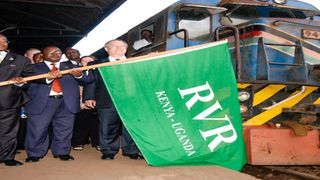
Kenyan and Ugandan officials during the launch of Rift Valley Railways’ services in Nairobi. FILE PHOTO | NMG
|Business
Premium
Kenya plan to sell old rail as scrap triggers Sh286bn fight in London
A London-based international arbitration has heard that Kenya and Uganda secretly planned to kill Rift Valley Railways (RVR) and dispose of it as scrap to unlock billions from China for the construction of the standard gauge railway (SGR).
RVR operated the meter gauge railway (MGR) from Uganda to Kenya until its 25-year concession was terminated in 2017, just around the time Kenya unveiled its SGR passenger services.
In a claim before the International Arbitration Center (IAC) in London, KU Railway Holdings Limited and RVR Investments (PTY) Limited — the two shareholders of the RVR consortium — say they have a document showing that the two countries had all along been setting up the RVR for failure.
The companies are seeking $2,005,900,000 (Sh286.3 billion) from the Kenyan government for the wrongful termination of the concession.
According to them, Kenya and Uganda frustrated the RVR's efforts to seamlessly operate the meter gauge line across the two borders, culminating in its failure that saw the concession terminated.
As part of an amended interface agreement, the old gauge railway was to transport both the oil finds from Uganda and Kenya, with the latter promising to address the delays at the port of Mombasa and Malaba border.
“According to the claim, shortly after the Amended Interface Agreement was signed, GOK (Government of Kenya) and GOU (Government of Uganda) secretly agreed to repudiate their obligations under the Interface Agreement,” says the case brief.
“This allegation is based on a document titled ‘SECRET Project Information Memorandum’ (“SGR Memo”) from August 2012. Allegedly, the SGR Memo stated that GOK would operationalize the SGR and then retire the MGR by selling it for scrap.”
The hearing of the case was scheduled to start on March 4 and will go on until March 15.
Kenya was also accused of giving the SGR a competitive advantage by slapping imported goods hauled on the MGR with a railway declaration levy that would be used to support the SGR.
Kenya terminated the 25-year contract that it signed with RVR to run its century-old meter gauge line to Uganda on July 31, 2017.
The decision was reached by consent made in the High Court between RVR and the Kenya Railways (KR) Corporation. The concession for the old railway line was signed in January 2006 by the administration of President Mwai Kibaki.
In its counter-claim, the Kenyan government, however, argued that RVR’s failure was not due to the SGR but because it did not make sufficient investment in the business to make it competitive.
About the SGR Memo, Kenya has argued that the document was improperly obtained and thus should not be admitted.
“That the Claimant ought not, or should not be allowed or permitted to rely on illegally or improperly obtained evidence to support their case…The improperly or illegally obtained evidence refers to a purported Secret Memorandum by the GoK.”
The Concession, the government said, failed because RVR did not sufficiently invest in the railway, procure sufficient consumables, procure sufficient rolling stock, and failure to maintain the railway.
The failure, the government added, was also due to corrupt practices by the RVR.
The KR and its Ugandan counterpart were to receive a concession fee of 11 percent on the RVR traffic. However, RVR never paid any concession fee.
“The alleged loss of business relating to the negotiations between the Claimant and oil exploration companies for the transportation of oil by railway did not arise. The claimant had failed to negotiate a single contract, they had not provided an adequate assessment of the alleged loss, and the venture was not commercially viable.”
Around the time that Kenya terminated the 25-year contract with RVR, former President Uhuru Kenyatta also launched the SGR, which was also, at least initially, supposed to retrace the inter-country route taken by the Britain-built MGR.
The initial plan for the Chinese-built SGR was for the modern railway — just like the British Lunatic — to have a regional reach, enabling it to pick up higher traffic volumes from Kenya, Uganda, and Rwanda.
The two companies said that they were not opposed to the construction and operationalisation of the SGR.
“Rather, their main issue was the failure by the GOK to indemnify it for the losses accrued as stipulated under the Amended Interface Agreement,” they said.
Interestingly, the SGR also terminates at Naivasha from Mombasa, a situation that has made it uneconomical for some traders who still have to pay more for the last-mile haulage.





